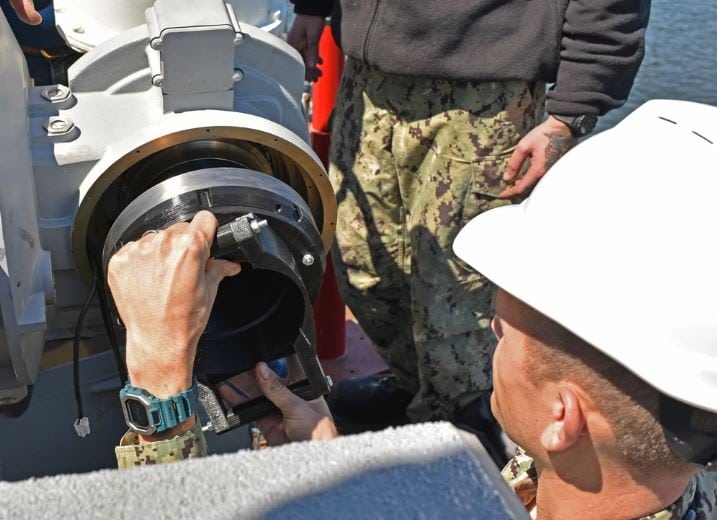Sometimes, one maintenance and modernization effort inspires another. What’s even better? When one team’s work to solve a problem leads to a solution that could eventually help keep systems in service longer, at reduced cost, across the entire Navy enterprise. That solution-to-scale happened recently at Southeast Regional Maintenance Center (SERMC), when delicate repairs to a new aspect of an established gun-based weapon system challenged the steady hands and technical experience of a team working on the MK 15 Phalanx Close-in Weapons System, known as CIWS – or, sometimes, “sea wiz.”
Since 1980, the U.S. Navy and its allies have used CIWS as a countermeasure for ships to use in defense against anti-ship missiles, aircraft and littoral warfare threats that have breached other fleet defenses. The current CIWS variant (Block 1B) adds the ability to defeat small, high-speed surface craft and unmanned aerial drones using an integrated and stabilized electro-optical sensor.
The new capability’s motors are precise pieces of machinery. That’s an advantage when it comes to pinpoint accuracy, but can present difficulties when it’s time to repair or replace them.
“The elevation and azimuth axes movements on the Electro-Optical Stabilization Subsystem (EOSS) are controlled through two precision gear motors that stabilize the Phalanx Thermal Imager,” said SERMC’s Additive Manufacturing Coordinator Chief Machinist’s Mate Nicholas Heinrich. “The DC (direct current) motors are two different sizes and are housed deep within the EOSS housing, significantly complicating removal and replacement when required,” Heinrich added.
The previous method of motor replacement used lock wiring or electrical cables attached to the brush-ring mounting holes. “We were utilizing wire straps anchored to the motor for removal and replacement, and while that solution was functional, it was heavily dependent on technique that came with experience because physical control of the new motor during reassembly was lacking, which resulted in a high failure rate (of the motors),” said Terry Henderson, a civilian CIWS Technician at SERMC.
If that sounds as simple as cracking a safe while wearing oven mitts, well, it can be.
“If done incorrectly, the DC motor can seize onto the hub due to the very tight tolerances and the magnetic pull of the motor. It was easy to damage the new motor when using light taps to unseize the motor during replacement,” Henderson said.
Because making repairs shouldn’t necessitate additional repairs, Heinrich and Henderson teamed up to create new, self-aligning motor removal tools that would prevent binding and greatly reduce overall maintenance time necessary to address the complex removal and installation of these precisely manufactured components.
The team first tried a tool machined from aluminum. It had narrow handles with limited grip, was free-moving, and still required an experienced technician to prevent binding during replacement. The team wasn’t satisfied.
Next, they switched to a 3D-printed model they created using one of the newer, more powerful printers at SERMC. The printer produced a device that is ergonomic and easy to use, and improves the operational readiness of the electro-optic device. The entire process, from initially brainstorming the aluminum device to successfully testing the 3D-printed tools, took approximately six weeks.
“3D printers provide opportunities for creative problem-solving by empowering Sailors to take ownership of their repairs,” SERMC Commanding Officer Capt. Justin Dowd said. “SERMC’s continuing technological growth is possible because someone in our organization said, ‘There’s a better way to do this,’ and took advantage of our additive manufacturing capabilities.”
That creative design work, combined with today’s technology, has turned a nerve-wracking task into a straightforward effort, even for relatively novice maintainers.
“The self-aligning design we came up with allows the motors to be quickly and easily removed or installed with great precision, while maintaining positive control and perfect alignment of the DC motor. Our handle prevents binding by concentrically aligning the motor to the support sleeve, so technique is no longer a requirement, enabling seizure-free replacement of the motor every time, regardless of the individual skill level involved,” Heinrich said.
The new tools, at a production cost of between $30 and $40 each, significantly improve CIWS operational readiness through reduced maintenance downtime, and increased accuracy due to self-aligning design, ease of use, low cost and ease of production. The tools save approximately 40 minutes of maintenance time per replacement on the elevation side, and approximately four hours on the azimuth side. Now that the tools are in use, it’s clear that they can make a difference beyond the repair shop at SERMC.
“With a U.S. Navy Fleet population of approximately 250 CIWS systems, each with two motors, this maintenance function will be required at least once within the systems’ service life. When you include our NATO Allies and the United States Army, which fields the same weapon system on land, the rollout of these tools will be a huge benefit to our national defense,” Henderson concluded.
SERMC has made the design blueprints available to Mid-Atlantic Regional Maintenance Center, and is obtaining patents through the Record of Invention process.
For more information about Southeast Regional Maintenance Center, please visit our homepage and Facebook page:
https://www.navsea.navy.mil/Home/RMC/SERMC/
https://www.facebook.com/SoutheastRMC/
Subscribe to AM Chronicle Newsletter to stay connected: https://bit.ly/3fBZ1mP
Follow us on LinkedIn: https://bit.ly/3IjhrFq
Visit for more interesting content on additive manufacturing: https://amchronicle.com


